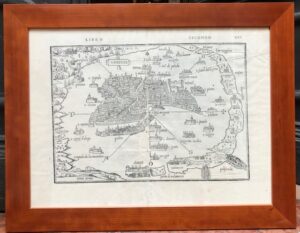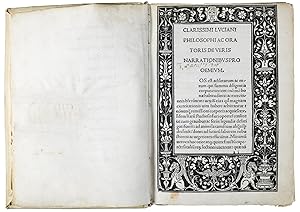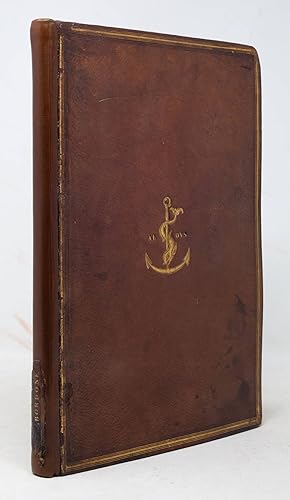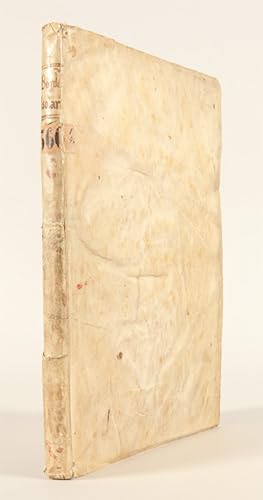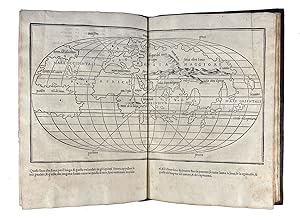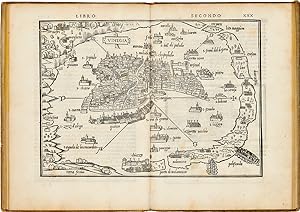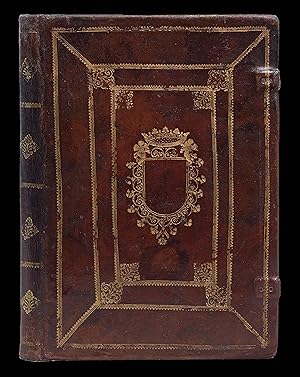BORDONE, BENEDETTO (30 resultados)
Tipo de artículo
- Todo tipo de artículos
- Libros (23)
- Revistas y publicaciones
- Cómics
- Partituras
- Arte, grabados y pósters (5)
- Fotografías
- Mapas (2)
-
Manuscritos y
coleccionismo de papel
Condición
Encuadernación
- Todo
- Tapa dura (16)
- Tapa blanda
Más atributos
- Primera edición (4)
- Firmado
- Sobrecubierta (8)
- Con imágenes del vendedor (18)
- Sin impresión bajo demanda (29)
Gastos de envío gratis
Ubicación del vendedor
Valoración de los vendedores
-
Libro di Benedetto Bordone : Nel qual si ragiona de tutte l'isole del monde, con li lor nomi antichi & moderni, historie, fauole, & modi del loro uiuere, & in qual parte del mare stanno, & in qual parallelo & clima giacciono. Con il breve di papa Leone . Et gratia et priuilegio della illustrissima Signoria com' in quelli appare (1528) [LeatherBound]
Año de publicación: 2023
Librería: True World of Books, Delhi, India
Libro Impresión bajo demanda
LeatherBound. Condición: New. LeatherBound edition. Condition: New. Reprinted from 1528 edition. Leather Binding on Spine and Corners with Golden leaf printing on spine. Bound in genuine leather with Satin ribbon page markers and Spine with raised gilt bands. A perfect gift for your loved ones. NO changes have been made to the original text. This is NOT a retyped or an ocr'd reprint. Illustrations, Index, if any, are included in black and white. Each page is checked manually before printing. As this print on demand book is reprinted from a very old book, there could be some missing or flawed pages, but we always try to make the book as complete as possible. Fold-outs, if any, are not part of the book. If the original book was published in multiple volumes then this reprint is of only one volume, not the whole set. Sewing binding for longer life, where the book block is actually sewn (smythe sewn/section sewn) with thread before binding which results in a more durable type of binding. Pages: 184.
-
Isolario.
Publicado por Edizioni Aldine, Modena,, 1983
Librería: FIRENZELIBRI SRL, Reggello, FI, Italia
Condición: COME NUOVO. Introduzione di Massimo Donattini. Isolario di Benedetto Bordone nel qual si ragiona di tutte l'isole del mondo : con li lor nomi antichi & moderni, historie, fauole, & modi del loro viuere, & in qual parte del mare stanno, & in qual parallelo & clima giaciono; Con la gionta del Monte del Oro nouamente ritrouato; Con il breve del papa; et gratia & priuilegio della illustrissima Signoria di Venetia come in quelli appare cm.25x35, pp.23,LXXIII, Contenente, dopo una ampia introduzione, la ristampa anastatica dell'edizione del 1534. Modena, Edizioni Aldine cm.25x35, pp.23,LXXIII, legatura editoriale in tutta tela, sopracoperta figurata. Cofanetto. Contenente, dopo una ampia introduzione, la ristampa anastatica dell'edizione del 1534. legatura editoriale in tutta tela, sopracoperta figurata. Cofanetto.
-
Isolario.
Publicado por Ed. Aldine,, Modena,, 1983
Librería: Studio Bibliografico Benacense, Riva del garda, Italia
Cm. 35, pp. 23 (1) + cc. LXXIIII comprendenti la ristampa dell'edizione del 1534. Con illustrazioni nel testo. Leg. edit. in tela con sovracop. ill. Ben conservato.
-
Libro.De Tutte L'isole Del Mondo
Publicado por Theatrum Orbis Terrarum LTD., Amsterdam, 1966
Librería: T. W. Palmer Books, Eugene, OR, Estados Unidos de America
Libro
Hardcover. Condición: As New. Estado de la sobrecubierta: As New. 31.5 x 21.5 cm., 73 pp., facsimile of Venice 1528.
-
Libro . De Tutte L'Isole Del Mondo Venice 1528
Publicado por Theatrum Orbis Terrarum Ltd., Amsterdam, 1966
Librería: From Away Books & Antiques, Greenville, ME, Estados Unidos de America
Libro Original o primera edición
Hardcover. Condición: Very Good. Estado de la sobrecubierta: Very Good. 1st Edition. VERY GOOD/ VERY GOOD: Very Good Copy of the First Edition of the Theatrum Orbis Terrarum Facsimile. Erratum Slip laid in. Dust Jacket is Very Good with only minor wear. Location: V16.
-
Isolario. Introduzione di Massimo Donattini.
Publicado por Edizioni Aldine,, Modena,, 1983
Librería: La Darsena di Leonelli Siro e C. s.a.s., Modena, MO, Italia
Cm. 34, tela rig. edit. con sovracop. e custodia rigida, pag. 23 (3) (20) (148) (4). Bella edizione in fac simile dell'edizione del 1534. Ottimo esemplare.
-
Libro . de tutte l'isole del mondo.
Librería: Antiquariaat A. Kok & Zn. B.V., Amsterdam, Holanda
Venice, 1528. [Reprint Amst., 1966]. XII,[166] pp. [82] small b./w. maps. Hardcover, no d./j. Sm. folio. (Theatrum Orbis Terrarum , 3rd series, vol. I). With an introduction (12 pages) in English by R.A. Skelton. - Facsimile reprint of: Libro di Benedetto Bordone nel qual si ragione de tutte l'isole del mondo [.]. (Vinegia, Nicolò Zoppino, 1528).
-
Libro . de tutte l'isole del mondo.
Librería: Kloof Booksellers & Scientia Verlag, Amsterdam, Holanda
Condición: very good. With an introduction by R.A. Skelton. Amsterdam : Theatrum Orbis Terrarum, c1966. Orig. cloth binding. Dustjacket. xii,[16],74 pp. Maps. 32 cm. (Theatrum orbis terrarum ; 3rd series, volume 1). Dustjacket sl. frayed. - Reprint of Venice 1528-edition. Original titel : Libro de Benedetto Bordone. Nel qual si ragiona de tutte l'isole del monde, con li lor nomi antichi & moderni, histoire, fauole, & modi del loro uiuere, & in qual parte del mare stanno, & in qual parallelo & clima giacciono. Con il breve di papa Leone, 1528. Supreme and last work of the Venetian Benedetto Bordone (1460-1531), where he wanted to offer a tutorial, cultural and divertive text to contribute to the scientific geographical knowledge of the islands. He combined historical sources with geographic and cartographic data, like the islands's geographic parallel, the distance between them, the coastline lenght and the insular biota The book with 82 illustrations, 43 from the Mediterranean Sea, 29 from the Atlantic Ocean and 10 from the East Seas, became a popular travel narrative, attracted many readers and was reprinted numerous times for almost half a century. Additional shipping charges will be requested for international orders. Condition : very good copy. Keywords : ,
-
Libro. De Tutte L'Isole Del Mondo Venice 1528
Publicado por Theatrum Orbis Terrarum, Amsterdam, 1966
Librería: Daedalus Books, Portland, OR, Estados Unidos de America
Miembro de asociación: CBA
Hardcover. Condición: Very Good+. Estado de la sobrecubierta: No Dust Jacket. 4to.
-
Libro . de tutte l'isole del mondo, Venice 1528. With An Introduction By R.A. Skelton
Publicado por Theatrvm Orbis Terrarvm for The, 1966
Librería: Midtown Scholar Bookstore, Harrisburg, PA, Estados Unidos de America
Hardcover. Condición: Good. Some shelfwear and scuffing to the dj, otherwise in great shape - in our rare books collection - may have remainder mark or previous owner's name Oversized.
-
Isolario
Publicado por Les Belles Lettres & Nino Aragno Editore, Paris, 2000
ISBN 10: 2251190031ISBN 13: 9782251190037
Librería: Luigi De Bei, PREGANZIOL, TV, Italia
Libro Original o primera edición
Rilegato. Condición: nuovo. Estado de la sobrecubierta: nuovo. prima edizione. Benedetto Bordone,Isolario con una prefazione di Umberto Eco,Paris 2000.Les Belles Lettres & Nino Aragno Editore Pagine 85 circa ills. Language : French and Italian text.
-
Isolario. Préface de Umberto Eco
Año de publicación: 2000
Librería: Libreria Piani, Monte San Pietro, BO, Italia
Libro
Torino, Les Belles Lettres/Aragno, 2000, 4to elegante legatura editoriale in tutta tela nera con titoli dorati al piatto anteriore e al dorso, sovraccoperta illustrata, pp. XII, (19), 74, (3) con numerose illustrazioni nel testo. Copia anastatica dell'edizione di Venezia del 1534. Stato di nuovo.
-
Lissa, Cherso, Ossero
Publicado por Venezia, 1540
Librería: libreria antiquaria perini Sas di Perini, Verona, VR, Italia
Arte / Grabado / Póster
Silografia, mm 83x146 (su foglio 290x200), colorata. Coppia di incisioni, tratte da "Isolario nel qual si ragiona di tutte le isole del mondo" pubblicato dal 1528 al 1562. Una delle prime raffigurazioni di Lissa accompagnata al verso da una silografia, mm 80x145, di Cherso Ossero Veglia e Arbe. Ottimo esemplare. Nr.cat: cod 9998.
-
Libro.De Tutte L'Isole Del Mondo Venice 1528 With An Introduction By R.A. Skelton [Atlases In Facsimile Third Series-Volume I].
Publicado por Amsterdam: Theatrum Orbis Terrarum Ltd. for The World Publishing Company, Cleveland & New York, 1966., 1966
Librería: D & E LAKE LTD. (ABAC/ILAB), Toronto, ON, Canada
Hardcover. Dust Jacket Included. folio. pp. xii, [166]. 111 woodcut maps in the text. cloth. dw. (dw. lightly rubbed, extremities bit chipped).
-
S.M. de Tremidi (Tremiti) - Liezena (Lesina) - Curzola
Publicado por Venezia, 1540
Librería: libreria antiquaria perini Sas di Perini, Verona, VR, Italia
Arte / Grabado / Póster
Silografia, mm 83x146 (su foglio 290x200), colorata. Tratta da "Isolario nel qual si ragiona di tutte le isole del mondo" pubblicato dal 1528 al 1562. Una delle prime raffigurazioni delle Tremiti accompagnata al verso da due silografie mm 80x145 di Lesina e Curzola. Ottimo esemplare. Nr.cat: cod 1175-1176.
-
Mazorbo, Chiozza, Parte de Schiavonia
Publicado por Venezia, 1540
Librería: libreria antiquaria perini Sas di Perini, Verona, VR, Italia
Arte / Grabado / Póster
Silografie, mm 83x146 (su foglio 290x200). Coppia di incisioni, tratte da "Isolario nel qual si ragiona di tutte le isole del mondo" pubblicato dal 1528 al 1562. Una delle prime raffigurazioni di Chioggia e di Mazorbo accompagnate al verso da una silografia, mm 80x145, del Quarnaro con Cherso Veglia Pago e Arbe (questa colorata a mano). Ottimo esemplare. Nr.cat: cod 1173-1174.
-
Taprobana.
Publicado por Venezia,, 1540
Librería: libreria antiquaria perini Sas di Perini, Verona, VR, Italia
Arte / Grabado / Póster
Silografia, mm 147x193 (su foglio 300x208). Tratta da "Isolario nel qual si ragiona di tutte le isole del mondo" pubblicato dal 1528 al 1562. Una delle prime raffigurazioni di Taprobana, oggi Sri Lanka. Ottimo esemplare con lievissimo alone nel margine sup. che intacca appena l'interno della linea di inquadramento.
-
Corphu.
Año de publicación: 1528
Librería: Altea Antique Maps, London, Reino Unido
Mapa Original o primera edición
Venice, 1528. Woodcut, image 85 x 145mm, set in Italian text. Worm hole in margin otherwise a very fine example. One of the first printed maps of Corfu, published in the first edition of the 'Libro di Benedetto Bordone', better known as Bordone's 'Isolario'. On the reverse is a map of Paxos. Despite the six editions between 1528-1562 these maps are rare on the market. ZACHARAKIS: 482.
-
[Corsica.]
Año de publicación: 1534
Librería: Altea Antique Maps, London, Reino Unido
Mapa
No Binding. Condición: Very Good. Venice, 1534. Woodcut, image 85 x 145mm, set in Italian text. Fine condition. Sea chart of Corsica, with Elba and Capraia, with another map, centred on Pianosa on verso. Published in the 'Libro di Benedetto Bordone', better known as his 'Isolario'. Despite the six editions between 1528-1562 these maps are rare.
-
VENEZIA ? PIANTA PROSPETTICA DELLA CITTA' E DELLE LAGUNE BORDONE
Publicado por 1534 circa, 1534
Librería: AL VECCHIO LIBRO, Bassano del Grappa, Italia
INTERESSANTE E RARA PIANTA XILOGRAFICA DI VENEZIA, PROVENIENTE DALL'ISOLARIO DISEGNATO DA BENEDETTO BORDONE E DATO ALLE STAMPE LA PRIMA VOLTA NEL 1528. SONO STATE FATTE ALTRE EDIZIONI, INVARIATE NEI CONTENUTI, NEL 1534, 1537 E 1547.DA "VENETIA , LE IMMAGINI DELLA REPUBBLICA ." : " .E' IL PRIMO ESEMPIO CONOSCIUTO DI RAPPRESENTAZIONE DELL'INTERA LAGUNA, OTTENUTA DEFORMANDO IL RAPPORTO DELLE DISTANZE TRA LA CITTA' E LE ISOLE PER PERMETTERE LA VISIONE ENTRO I LIMITI NECESSARIAMENTE ESIGUI DEL FOGLIO" L'ESEMPIO SRA' IN SEGUITO ELETTO A SISTEMA.BEL FOGLIOMISURE FIGURA 22,5 X 32,8 CMMISURA FOGLIO 40 X 30 CIRCA.
-
[Greece & the ?gean.] (Grecia Egeo)
Publicado por Venezia, 1528
Librería: libreria antiquaria perini Sas di Perini, Verona, VR, Italia
Arte / Grabado / Póster
Woodcut, mm 295 x 400, Italian text indexes on verso. Good condition.Sea chart of Greece and the ?gean, but also reaching Istanbul, Turkey, Crete and Cyprus. Published in the Third Book of the 'Libro di Benedetto Bordone', better known as 'Isolario'. Despite the six editions between 1528-1562 these maps are rare. Right margin and bottom margin frayed at left handside. NORDENSKIOLD: 27; ZACHARAKIS: 3rd ed. 481. Nr.cat: PA260155.
-
Untitled World Map.
Publicado por [Venice: 1528/1547], 1547
Librería: Arader Galleries - AraderNYC, New York, NY, Estados Unidos de America
No Binding. Condición: Good. "Double-page woodcut world map on an oval projection from Bordone's Isolario (Image: 8 1/4 x 14 3/4 in.; 21 x 37.5 cm. Sheet: 11 1/4 x 15 in.; 28.6 x 38.1 cm), verso bears signature "DD." BINDING/CONDITION: One light spot, else fine. Unbound, hinged to a mat. (65B1A) A BRIGHT COPY. "For a long time Bordone's world map was cited as the first drawn on an oval projection, prior to the discovery of Francesco Rosselli's map of c. 1508 using this form of construction. References within Bordone's book indicate that he had been occupied on its compilation for many years prior to publication his 1528 map is undoubtedly based on Rosselli's oval one although there are several points of difference; for instance the omission of all antarctic lands and the separation of Asia and America. Rosselli's truncated form of South America is retained" (Shirley). PROVENANCE: Sotheby's New York, Fine Manuscript and Printed Americana, 24 January 2019, lot 2034 REFERENCE: Shirley 59".
-
Commentaria in Bibliam. Ed: Bernardinus Gadolus
Publicado por Venice Johannes and Gregorius de Gregoriis, de Forlivio 1497 - 25 August 1498, 1498
Librería: PrPh Books, New York, NY, Estados Unidos de America
Miembro de asociación: ILAB
Three volumes, folio (341x223mm). Collation: I. A8, <2-3>6, <4-6>6, a-c8, d10, e8, f6, g-h10, i8, k6, l-u8, x-y6. Fol. o3 signed m3. II. A-R8, S10, T-Z8, AA-BB8, CC6, DD-HH8, DDD-EEE8, FFF-HHH6, DDDD-GGGG6, HHHH4, II8, KK-LL6. III. Collation: aa-ff8, ll-ss8, tt10, vv-zz8 (yy8 blank), ee12-1, a8,b-c6, AA6, aAA8 (fol. aAA blank), BBb-PPp8, QQq6. In all 839 of [845] leaves, lacking, as usual, quire BB6, including the registrum. Text in one column, 48-61 lines. Type: 20:170G, 32*:83G, 39:82R. Large woodcut printer's device on fols. PPp8r and QQq6r. White-on-black woodcut candelabra border and fourteen-line animated initial depicting St. Jerome on fol. aAA2r. Woodcut decorated, and animated initials throughout, mostly on black ground. Late nineteenth-century quarter-mottled leather, over pasteboards. Boards covered with marbled paper. Spines with three raised bands, title lettered in gilt. Covers abraded in places; spines lightly damaged at the top. A good copy, some stains, spots, and waterstains. A few fingermarks, old repair to the upper blank leaves of the first leaf of the first volume, without any loss. Contemporary marginalia in the third volume. Modern, pencilled foliation in the upper corner of the leaves, bibliographical notes on the pastedowns and flyleaves.Provenance: Giovanni di Maffio, San Giovanni Valdarno, Arezzo (ownership inscription dated 1532 'Di giouannj di maffio di ualdarno di sopra', on the recto of the first leaf of each volume); from the library of the Franciscan monastery St. Bonaventura al Bosco, Tuscany (ownership inscription, partly erased and dated 1545, 'Della libraria del bosco di mugello [?] da Biagio [?]', on the recto of the second leaf of the first volume, and on the first leaf of the second and third one). This Venetian edition of Jerome – edited for the de Gregoriis brothers by Bernardinus Gadolus – contains on fol. aAA2r, around the first text-page of the Expositio in Psalterium, a re-use of one of the finest woodcut borders of the fifteenth century: the white-on-black woodcut border drawn and cut by Benedetto Bordone (1450/55-1530) for the Herodotus issued by the same printing house in 1494 (see no. 36). The latter publication contained a large woodcut depicting the Greek historian crowned by Apollo, which is replaced here with a fourteen-line animated initial showing St. Jerome at his desk. There are numerous other ornamental initials throughout the text, some of them with paired dolphins and mostly on black ground. The present edition is a handsome example of the extraordinary imagery and inventiveness of Benedetto Bordone. He was a great protagonist of the multi-faceted world of the Venetian book; a skilful miniaturist from Padua, he learned to profit from the Venetian printing industry and was capable of re-defining and developing his artistic talent, adapting it to the newly produced printed books, and becoming, in the early sixteenth century, one of the most esteemed and sought-after designers among all the printers active in the Venetian calli and campi, with a special link to the Aldine Press (see no. 43). An erudite and versatile artist, he shared with Aldus clients, friends, and patrons, but above all a life-long passion for the ancient world and its artful transmission to their contemporaries.H 8581*; GW 12419; BMC V, 350; IGI 4729; Goff H-160; Essling 1170; Sander 3386; L. Armstrong, "Benedetto Bordon, 'Miniator', and Cartography in Early Sixteenth-Century Venice", Eadem, Studies of Renaissance Miniaturists in Venice, London 2003, 2, pp. 591-643; Philobiblon, One Thousand Years of Bibliophily, no. 40. Book.
-
Vera historia. Tr: Lilius (Tifernas) Castellanus. Add: De asino aureo; Philosophorum vitae; Scipio; Tyrannus; Scaphidium (Dialogus de funerali pompa); Palinurus; Charon; Diogenes; Terpsion; Hercules; Virtus dea; In amorem; Timon; Sermo de calumnia; Laus muscae. Ed: Benedictus Bordonus; Maephus Vegius: De Felicitate et miseria
Publicado por Venice Simon Bevilaqua, for Benedetto Bordone 25 August 1494, 1494
Librería: PrPh Books, New York, NY, Estados Unidos de America
Miembro de asociación: ILAB
4° (216x155 mm). Collation: a8, b4, c-g8, h4, i-p8. [112] leaves. Text in one column, 29 lines. Type: 5:110R. White on-black woodcut candelabra border on fol. a2r, by Benedetto Bordone. Blank spaces for capitals, with no guide letters. Later vellum over pasteboards. Smooth spine, title written vertically 'Lucianus Venice Woodcut title-border'. Binding somewhat bumped. A good copy, first leaf lightly soiled, with old repair to the outer blank margin, without any loss. A few small stains, some spots and fingermarks. The lower blank margin of fol. g7 slightly trimmed. A few early marginal and interlinear notes. On the rear pastedown, a cutting taken from an old sale catalogue describing this copy: "Fol. a2 is surrounded by a magnificent woodcut border [.] Such borders are very rare in books of small format. A very fine copy of a rare book, save for the first page, skilfully repaired". Bibliographical notes on the front pastedown (among these '217x153. BM copy only 204x143'), and on the recto of the front flyleaf. On the rear pastedown, pencilled collation by Bernard Quaritch.Provenance: the bibliographer Gilbert Richard Redgrave (1844-1941; ex-libris on the front pastedown, and the inscription on the recto of the front flyleaf "Ex libris. Gilbert R. Redgrave Thriffwood, Sydenham, London. Sept. 9th. 1914'); Wynne Rice Hugh Jeudwine (1920-1984; ex-libris on the front pastedown; see sale Bloomsbury London, 18 September 1984 Catalogue of the Important Collection of Printed Books formed by the Late W. R. Jeudwine, lot 18); Kenneth Rapoport (ex-libris on the front pastedown). A fine copy of the rare first book edited by famous Paduan artist Benedetto Bordone (1450/55-1530). This edition represents the first official appearance of Bordone's name in Venice. On 3 May 1494, Benedictus miniator applied for permission to print a book edited by himself, a Latin translation of Lucian's dialogues. The book was published on 25 August by Simone Bevilaqua (active in Venice between 1492 and 1506) at Bordone's expense, and his name is mentioned in a final address, composed in verse, on fol. p6r, and in the statement of privilege printed on the verso of the same leaf. In the four-verse address, Bordone invites the reader to take this book and relax among the collected stories of Lucian. It is indeed an enjoyable book, featuring widespread texts without scholarly commentaries or notes, printed in a roman type that is easy to read, and in a small quarto format, a practical prelude to the well-known Aldine octavos. The title page is framed within an exquisite woodcut all'antica border on black ground whose design is attributed to Bordone himself. This delicately refined candelabra border is a compendium of decorative motifs from classical antiquity: vases, vine leaves, and foliate branches, with the head of a 'leafy old man' at top and a Roman eagle, horns, and winged animals down below. This woodcut border was first used, with some variants, in the 1494 Herodotus (see no. 36), and later in the Commentaria in Bibliam by Hieronymus (see no. 40). Single elements of Bordone's decorative vocabulary also find close parallel in headpieces and initials used by Aldus in the years 1495-1498. This copy was bought in 1914 by Gilbert Richard Redgrave, son of the famous British artist Richard Redgrave and president of the Bibliographical Society of London, as well as co-editor, with Alfred W. Pollard, of A Short-Title Catalogue of Books Printed in England, Scotland, e Ireland and of English Books Printed Abroad, 1475-1640. A note on the front flyleaf written in his own hand states: 'All writers on book ornament agree in attributing the splendid border on f. a2 to the same designer as the border of the Herodotus of 1494. These two borders are the most splendid works on the early Venetian press'.HC 1026; GW M19059; BMC V, 519; IGI 5842; Goff L-329; Flodr Lucianus, 4; Essling 747; Sander 4037; L. Armstrong, "Benedetto Bordon, 'Miniator', and Cartography in Early Sixtee. Book.
-
Commentaria in Bibliam. Ed: Bernardinus Gadolus. Venice, Johannes and Gregorius de Gregoriis, de Forlivio, 1497 - 25 August 1498.
Publicado por Venice, Johannes and Gregorius de Gregoriis, de Forlivio, 1497 - 25 August 1498., 1498
Librería: PrPh Books, New York, NY, Estados Unidos de America
Miembro de asociación: ILAB
Hardcover. Condición: Very Good. Two volumes, folio (317 x 209mm). Collation: I. A8, 6, 6, a-c8, d10, e8, f6, g-h10, i8, k6, l-u8, x-y6. A-R8, S10, T-Z8, AA-BB8, CC6. II. DD- HH8, DDD-EEE8, FFF-HHH6, DDDD-GGGG6, HHHH4, II8, KK-LL6, aa-ff8, ll-ss8, tt10, vv-zz8 (yy8 blank), &&12-1, aAA8 (fol. aAA blank), BBb- NNn8, OOo6, PPp8, QQq6, a8, b-c6, AA-BB6. Complete with 845 leaves, including quire BB6, often lacking. Text in one column, 48-61 lines. Type: 20:170G, 32*:83G, 39:82R. Large woodcut printer s device on fols. PPp8r and QQq6r. White-on-black woodcut candelabra border and fourteen-line animated initial depicting St. Jerome on fol. aAA2r. Woodcut decorated, and animated initials throughout, mostly on black ground. Modern brown morocco, over pasteboards. A good copy, some dampstaining and toning, some leaves spotted, inkstains and some soiling, small repairs to blank corners and wormhole repairs in vol. 2, beginning of preface of Isaiah soiled with top and bottom margins renewed, final leaf soiled and chipped with small repair to blank area. Marginalia in several hands. Provenance: partially effaced ownership inscription from Mantua in vol. 2; acquired from the antiquarian bookshop of Leo S. Olschki, Florence, 28 December 1965. The Venetian edition of Jerome s fourth and fifth-century commentaries accompanying his Latin translation of the Bible, edited for the de Gregoriis brothers by Bernardinus Gadolus and containing, on fol. aAA2r, a re-use of one of the finest woodcut borders of the fifteenth century: the white-on-black woodcut border drawn and cut by Benedetto Bordone (or Bordon, 1450/55-1530) for the Herodotus issued by the same press in 1494. The exquisite all antica border described by Essling as a magnificent frame on a black ground, so justly praised [.] the most perfect type of decorative art applied to the ornament of the book includes birds, vases, pilaster-forms, and vegetal and candelabra motifs. It is often connected to the marvelous woodcut border likewise attributed to Bordone and included in the Lucian of 1494, which Bordone himself also edited and which represents the first official appearance of the Paduan native s name in Venice. Both borders exhibit the same delicate refinement and inventiveness arrived at through the highly skilled miniaturist s adaptation of illumination techniques to woodcut design, an achievement that helps make him one of the most remarkable figures in the multi-faceted world of the Venetian book. The present border is, however, larger and more elaborate, with two large white-ground insets: at the top, one inset shows a satyr or horned faun preparing to sacrifice a goat, while at the bottom the other is understood to represent the celebrated episode of Hercules at the Crossroads, when the demigod must decide between Vice or Virtue. Here Hercules is seated on a marble bench with a dead or sleeping child at his feet, surrounded by a variety of female figures a clothed figure on the right with a turreted head, a nude figure on the left with a thread connecting a mask on one end to a rectangular structure on the other, and another clothed figure kneeling in front and potting a plant.The intriguing Hercules vignette is a variation on a drawing by Bernardino Parenzano of ca. 1490, held at Christ Church College. In turn an interpretation of an antique relief, the drawing in fact aligns with the less popular episode of The Madness of Hercules (in which the demigod kills Megara and their children together, believing them to be enemies while under the influence of vengeful Hera) and is replete with complex symbolism related to both the myth and to general reflections on human nature (D. Fasolini, Le linee della follia , p. 196). In his reworking and simplification of the drawing, Bordone brings the scenario back in line with the more famous (and commercially viable) Crossroads episode while retaining some of this enigmatic imagery. Adding further to the curious design is the inclusion of the .contd.
-
Isolario di Benedetto Bordone Nel qual si ragiona di tutte l'Isole del mondo, con li lor nomi antichi & moderni, historie, fauole, & modi del loro viuere, & in qual parte del mare stanno, & in qual parallelo & clima giaciono. Ricoreto, & di Nuouo ristampato. Con il breve del Papa Et gratia & priuilegio della Illustrissima Signoria di Venetia come in quelli appare
Publicado por (Paulus Manutius for) Federico Toresano, Venice, 1547
Librería: Arader Books, New York, NY, Estados Unidos de America
Original o primera edición
Hardcover. Condición: Very good. First. First Aldine edition (third overall). Venice: (Paulus Manutius for) Federico Toresano, 1547. Pot folio in 6s (11 3/4" x 8", 298mm x 203mm). [Full collation available.] With 3 double-page woodcut maps and a double-page woodcut plan of Venice, with another 100 or so woodcuts, all integral to the text. Bound in later (early XIXc?) brown morocco (re-backed, with part of the original back-strip laid down). On the boards, a quintuple gilt fillet border with gilt corner rosettes around a triple blind fillet border with blind corner fleurons. In the center of each board, the dolphin-and-anchor device flanked by "AL DVS". On the spine, "BORDONE" gilt. Gilt fillet to the edges of the boards and double gilt fillets to the turn-ins. Marbled end-papers. All edges of the text-block gilt. Re-backed, with part of the original back-strip laid down. Bumps to the upper fore-corners and some restoration to the extremities of the boards. A little watermarking to the front board. Booksellers' notes to the verso of the first free end-paper. Motto "D(EUS)/ NOBIS HAEC OTIA" ink manuscript to the bottom edge of the title-page. Benedetto Bordone (1460-1531) is best known as a miniaturist; he illustrated and illuminated texts and ducal decrees in Venice. His work extended into cartography, and in 1528 he published the first edition of his Isolario (he is also considered the originator of the map in an oval projection). Isolari emerged as a cartographic genre in the early XVc; they catalogued islands and the routes between them, which in the navigation of the Mediterranean was of signal importance. As horizons of exploration broadened, the book of islands was gradually superseded by the modern atlas as we know it from Ptolemy, Mercator and Ortelius. Bordone's Isolario stands right at the pinnacle of the genre, incorporating as it does extensive accounts of the Americas (especially Cuba, Venezuela, Brazil and Mexico; there is a fine plan of Temistican (Tenochtitlan, Mexico City) as it stood before Cortés) as well as advances in the topography West Indies. Indeed, though the shapes and relationships of these large islands -- Sumatra, Java, even a proto-Japan -- are imperfect, they were nonetheless among the earliest charts available. As the bookseller's note (verso of the front end-paper) explains, the Isolario is "never to be met with in decent condition, on account of its having been for years the only book of charts used by mariners of all nations." The printing history of the book is tangled with that of the families of Aldus Manutius and Andrea Torresano d'Asola. Aldus -- whose prominence in the history of Venetian bookmaking need not be detailed -- partnered with and married the daughter of Torresano, Maria. Torresano also had two sons, Giovanni Francesco and Federico, who continued their father's business (using his surname) while Aldus's sons (printing as "fili d'Aldo"), Paulus, Marco and Antonio, came to their majority after Aldus's death in 1515. Once they did, there was conflict between the Torresani and the "fili d'Aldo" over the rights to the plant and to the intellectual property of their forebears. The rift was finalized in 1539, but the aura of Aldus still hovered around the Torresani (Renouard includes this in his list of Paulus Manutius' productions). Thus the binding owner emblazoned his copy with the Aldine anchor. The only clue we have to the identity of the owner is the motto at the lower edge of the title-page: "deus nobis haec otia" [fecit], which can be rendered "god has made these comforts for us" (Vergil, Eclogue I.6). The motto is used by the city of Liverpool (granted March 1797), so perhaps the book came to be owned by a proud Liverpudlian. Adams B-2485; Burden, North America 8; Church 86; Harrisse 275; JCB (3) I:149; Renouard Annales des Aldes3 pp.141-142; Sabin 6421; Shirley 59.
-
ISOLARIO DI BENEDETTO BORDONE NEL QUAL SI RAGIONA DI TUTTE L'ISOLE DEL MONDO. RICORETO, & DI NUOUO RISTAMPATO
Publicado por Federico Toresano, Venice, 1547
Librería: William Reese Company - Americana, New Haven, CT, Estados Unidos de America
[10],74 leaves. Titlepage printed in red and black, with ornamental woodcut border, woodcut initials throughout. Full-page diagram of a world map and windroses; four woodcut double-page or folding maps; four smaller double-page maps; 103 other woodcut maps and plans scattered through the text. Small folio. Contemporary limp vellum, manuscript title on spine. Vellum somewhat wrinkled, with a few small tears along edges and spine. 18th century library shelf label on spine. Occasional faint foxing, small patch of dampstaining at fore-edge of rear leaves. Very good, in unsophisticated condition. First Aldine edition, and third overall, of Benedetto Bordone's important geographical compendium with early New World maps, containing a second printing of the earliest description in book form of Pizarro's conquest of Peru. Benedetto Bordone was born in Padua and worked in Venice as a geographer, cartographer, illuminator, and wood-engraver. It is believed that he was the creator of the first globe printed in Italy. First published by Nicolò d'Aristotile detto Zoppino in 1528 under the title LIBRO DI BENEDETTO BORDONE NEL QUAL SI RAGIONA DE TUTTE L'ISOLE DEL MONDO. The second edition printed in 1534, also by Zoppino, reused the same woodblocks for the maps, but appeared with a different title. The present edition kept the title of the second edition but used different woodblocks for the cuts. This work offers an illustrated guide to islands and peninsulas of the western ocean and New World, the Mediterranean, the Indian Ocean, and the Far East. As a cartographic form, Bordone's ISOLARIO derives from two manuscript prototypes, Buondelmonti's LIBER INSULARUM ARCHIPELAGI of 1420 and Da Li Sonetti's ISOLARIO of about 1485, whose maps were also drawn with eight windrays to establish orientation. Ptolemy's GEOGRAPHIA and nautical charts of the period are another source. This work is notable for its wide scope, spreading beyond the European/Western bounds of the well-known into the newly discovered areas in the Americas. In addition to text which includes information on Pizarro's triumph in Peru, the maps of the area are also particularly important. The map of the unnamed north coast of South America represents an early close illustration of what the Spanish referred to as "Terra Firma" and what would later comprise a large portion of the Spanish Main. Only four place names are given on the mainland: "Chanchite," "Cuztana," "Mazatambal," and "Paria," located in the Guianas. To the north lie Jamaica and Hispaniola, along with a cluster of other, most likely fictional, islands. The surrounding text describes Columbus' forays in the region, a menacing island of cannibals, and more. The West Indies and other islands off the coast of the Americas are treated in considerable detail. Jamaica, Hispaniola, Cuba, Guadeloupe, and Martinique are each represented in a separate map, while two additional maps of island groups show Antigua, St. Martin, Santo Domingo, Rodonda, Montserrat, a fictional island representation of Brazil, and others. Like many works of this genre, the text includes lengthy treatments of each island, complete with brief histories and fantastical myths. The famous oval world map shows all of the known regions of the globe. Europe, Africa, and Asia Major are clearly labeled; but North and South America remain "terra del laboratore" and "ponete modo novo (part of the new world)" respectively, despite following by forty years Martin Waldseemüller's assertion that the new lands ought to be called "America" after Amerigo Vespucci. A lovely Aldine edition of this important work of American cartography. EUROPEAN AMERICANA 547/2. HARRISSE BAV 275. PHILLIPS, ATLASES 164. CHURCH 86. JCB (3) I:149. RENOUARD 141:9. MORTIMER, ITALIAN 16th CENTURY BOOKS 82 (note). SABIN 6421.
-
Isolario. Nel qual si ragiona di tutte l'Isole del mondo, con li lor nomi antichi & moderni, historie, favole, & modi del loro vivere, & in qual parte del mare stanno, & in qual parallelo & clima giaciono. Con la gionta del Monte del Oro novamente ritrovato
Publicado por Nicolò d'Aristotile detto Zoppino, Venice, 1534
Librería: Donald A. Heald Rare Books (ABAA), New York, NY, Estados Unidos de America
Small folio. (12 x 8 3/6 inches). AA4 BB-DD2 A-M6 N8. 84 leaves. [20] I-LXXIII [1]. 94 pp. 112 woodcut maps, including 4 double-page maps of the world, Venice, the Mediterranean, and the Venetian Archipelago, full-page world map with wind roses, smaller maps across two-pages of Sicily, Crete, Cyprus, and Euboea, red and black letterpress title with ornamental woodcut border, woodcut initials. Contemporary brown morocco with gilt ruled panel and corner devices, spine gilt ruled into six compartments with center tool in each Second edition of this geographical compendium with historically significant New World maps, including the earliest description in book form of Pizarro's conquest of Peru. The author Bordone, born in Padua, worked in Venice as a geographer, cartographer, illuminator, and wood-engraver. It is believed that he was the creator of the first globe printed in Italy. First published by Nicolò d'Aristotile detto Zoppino in 1528 under the title Libro di Benedetto Bordone nel qual si ragiona de tutte l'isole del mondo, the present work, the second edition overall, marks the first appearance of the new title. The publisher re-used the same wood-blocks for the maps. An Aldine edition with the same title but different woodblocks followed in 1547. This work offers an illustrated guide to islands and peninsulas of the Atlantic ocean, the Mediterranean, the Indian Ocean, and the Far East. Bordone's Isolario derives from several manuscript prototypes, Buondelmonti's Liber insularum Archipelagi of 1420, Da Li Sonetti's Isolario (c.1485), and Ptolemy's Geographia. This work is notable for its wide scope, spreading beyond Europe into the newly-discovered areas in the Americas. In addition to text which includes the first mention in book form of Pizarro's triumph, the maps of the area are also particularly important. These include a plan of the city of Mexico (Temistitan), showing it before the conquest by Cortes. The "Terra de Lavoratore" map (on the verso of leaf VI) contains what is considered the first printed map of continental North America. The verso of leaf XII contains a map of Hispaniola, and the following leaf bears a map of Jamaica on the recto and one of Cuba on the verso. Other Caribbean islands depicted include Guadeloupe, Dominica, and Martinique. Also notable are the four double-page maps of the world (one of the earliest oval-projection world maps); Europe and northern Africa; the eastern Mediterranean; and Venice and the surrounding lagoon. This work also includes one of the earliest European representations of Japan. Adams A-2482. BM, Italian, p.120. Borba de Moraes I, p.112. Brunet I, 112. European Americana 534/2. Burden 8. Harrisse Bav 187. JCB (3) 1:112. Mortimer, Italian 82. Phillips, Atlases 162. Sabin 6419. Sander 1230. Shirley 59. Skelton, Introduction to Libro . . . de Tutte l'Isole del Mondo, passim.
-
LIBRO DI BENEDETTO BORDONNE NEL QUAL SI RAGIONA DE TUTTE L'ISOLE DEL MONDO.
Publicado por Nicolo Zoppino, Venice, 1528
Librería: William Reese Company - Americana, New Haven, CT, Estados Unidos de America
[10],73 leaves, including four double-page maps and two single-page maps, and numerous woodcut maps and plans in the text. A few leaves misnumbered. Small folio. 18th-century vellum, spine gilt, leather label. Boards and spine moderately soiled, leather label abraded. Titlepage printed in red and black with text printed inside decorative woodcut border. Slight age- toning and occasional foxing. Small worm holes in first thirty leaves, barely affecting a few printed characters on each page. A very good copy. The first edition of one of the earliest and most comprehensive works on the islands of the world, and a tremendous achievement of world cartography. Compared to the first work on world islands, or "Isolario," by Sonetti (circa 1485), which contained only forty-nine maps, the 105 maps and plans included in Bordone's effort mark a dramatic improvement in the attempt to map all known islands. Because of the rapid advances being made in the exploration of the New World, Bordone was able to include new cartographic representations of the north coast of South America, a substantial portion of New World island groups, and a new, dramatic rendering of the entire world. The map of the unnamed north coast of South America represents an early close illustration of what the Spanish referred to as "Terra Firma" and what would later comprise a large portion of the Spanish Main. Only four place names are given on the mainland: "Chanchite," "Cuztana," "Mazatambal," and "Paria," located in the Guianas. To the north lie Jamaica and Hispaniola, along with a cluster of other, most likely fictional, islands. The surrounding text describes Columbus' forays in the region, a menacing island of cannibals, and more. The West Indies and other islands off the coast of the Americas are treated in considerable detail. Jamaica, Hispaniola, Cuba, Guadeloupe, and Martinique are each represented in a separate map, while two additional maps of island groups show Antigua, St. Martin, Santo Domingo, Rodonda, Montserrat, a fictional island representation of Brazil, and others. Like many works of this genre, the text includes lengthy treatments of each island, complete with brief histories and fantastical myths. The famous oval world map shows all of the known regions of the globe. Europe, Africa, and Asia Major are clearly labeled; but North and South America remain "terra del laboratore" and "ponete modo novo (part of the new world)" respectively, despite following by twenty-one years Martin Waldseemüller's assertion that the new lands ought to be called "America" after Amerigo Vespucci. The map of "Ciampagu" is considered by some to be the earliest known map of Japan printed in Europe. "For a long time Bordone's world map was cited as the first drawn on an oval projection, prior to the discovery of Francesco Rosselli's map of c. 1508 using this form of construction. References within Bordone's book indicate that he had been occupied on its compilation for many years prior to publication.His 1528 map is undoubtedly based on Rosselli's oval one although there are several points of difference; for instance the omission of all antarctic lands and the separation of Asia and America. Rosselli's truncated form of South America is retained" - Shirley. Bordone did not limit himself to the creation of excellent maps for the use of contemporary navigators and explorers. The view of Mexico City, captioned "La Gran Citta di Temistitan," is one of the best early representations of the city, originally surrounded by water, before its destruction by Cortés. Numerous similar efforts that followed Bordone's work displayed an increasingly insular view of the North American continent, making his publication considerably accurate for its time. A beautifully produced book and a cornerstone of early Americana. HARRISSE 145. EUROPEAN AMERICANA 528/2. SABIN 6417. SANZ 1003. BORBA DE MORAES, pp.98-99. PHILLIPS ATLASES 162. JCB (3)I:98-99. SHIRLEY, MAPPING OF THE WORLD 59. KRAUS, WORLD ENCOMPASSED 83. BURDEN, MAPPING OF NORTH AMERICA 8. SUAREZ, SHEDDING THE VEIL 18. LeCLERC 181. RODRIGUES 426-27.
-
Isolario di Benedetto Bordone nel qual si ragiona di tutte l'Isole del mondo, con li lor nomi antichi & moderni, historie, fawle, & modi del loro viere, & in qual parallelo & dima giaciono. Ricorretto et di Nuovo ristampato. Con la gionta del Monte del Oro noiamente ritrouto.
Publicado por Francesco di Leno, [c1565]., Venice,, 1565
Librería: Daniel Crouch Rare Books Ltd, London, Reino Unido
Libro
Bordone's Isolario in contemporary binding Small folio, [10], title-page printed within woodcut borders, full-page diagram, 112 woodcut maps (of which seven are double-page), full contemporary calf, covers panelled with gilt stylised roll, foliate corner pieces, blank coat of arms, surmounted with a coronet. A particularly fine example of Bordone's 'Isolario' in a fine contemporary binding. Bordone's work is particularly important from an Americanist point of view, as it contains the "gionta del Monte del Oro novamente ritrovato" mentioned on the titlepage, the earliest authentic description of Pizzaro's entry into Peru to appear in a printed book. The isolario, or "book of islands", was a cartographic form introduced and developed in Italy during the fifteenth and sixteenth centuries. Like the portolano, or pilot-book, to which it was related, it had its origin in the Mediterranean as an illustrated guide for travellers in the Aegean archipelago and the Levant. Bordone's 'Isolario' was the second isolario to be printed and the first to give prominence to the transatlantic discoveries. Divided into three books, the 'Isolario' is devoted, respectively, to the "islands and peninsulas" of the western ocean, to the Mediterranean, and to islands of the Indian Ocean and the Far East. While this order corresponds very roughly to that of Ptolemy, it gives conspicuous priority to the discoveries across the Atlantic. In addition to a page of diagrams illustrating the construction of a circular world map and wind roses of "ancient" and "modern type", there are three general maps: Europe, the Aegean, and an oval world map. The work also contains 107 small maps, plans, or views, including a nearly three-quarter page plan of Mexico City before the conquest of Cortez which qualifies because it is an island. According to Cortazzi, the 'Isolario' also contains the earliest European printed individual map of Japan. Shirley, BL, T.BORD-1e; Shirley, World, 59.


![Imagen del vendedor de Libro di Benedetto Bordone : Nel qual si ragiona de tutte l'isole del monde, con li lor nomi antichi & moderni, historie, fauole, & modi del loro uiuere, & in qual parte del mare stanno, & in qual parallelo & clima giacciono. Con il breve di papa Leone . Et gratia et priuilegio della illustrissima Signoria com' in quelli appare (1528) [LeatherBound] a la venta por True World of Books](https://pictures.abebooks.com/inventory/md/md31618397429.jpg)



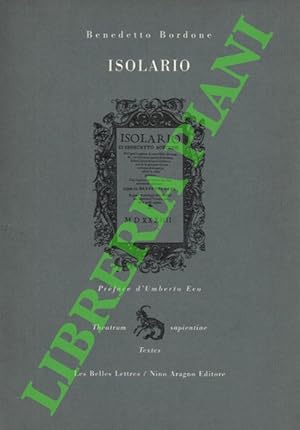
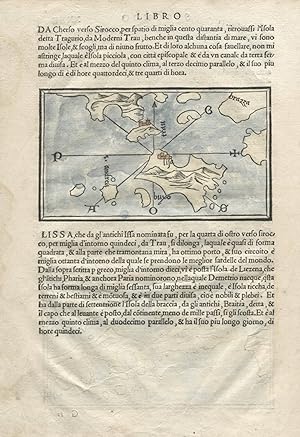
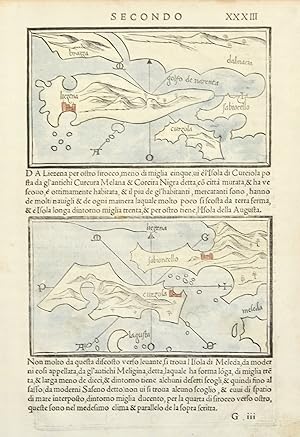

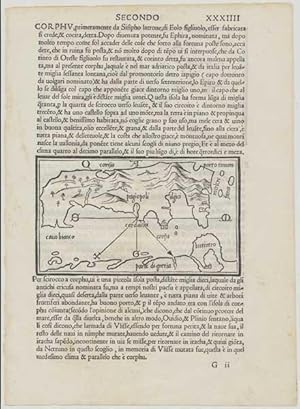
![Imagen del vendedor de [Corsica.] a la venta por Altea Antique Maps](https://pictures.abebooks.com/inventory/md/md13215282244.jpg)
